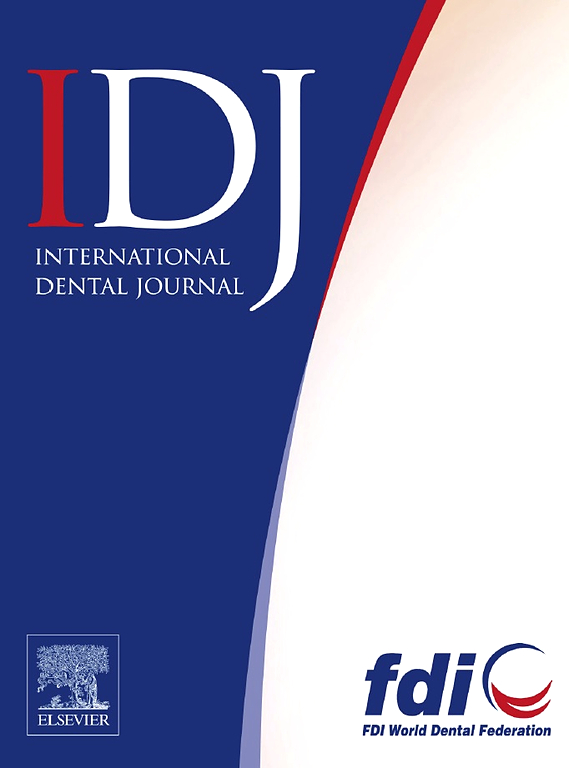咬合不对称与颞下颌疾病的相关性:一项横断面研究。
IF 3.2
3区 医学
Q1 DENTISTRY, ORAL SURGERY & MEDICINE
引用次数: 0
摘要
背景:牙合与颞下颌紊乱(TMD)之间的关系尚不清楚。目前的目的是探讨不对称遮挡特征(s)可能与tmd相关。方法:本研究纳入148例以错牙合为主诉的患者。其中84例无TMD征象(Group-ORD1), 64例有TMD征象(Group-ORD2)。另外84例以TMD症状为主诉并有正畸治疗史的患者被纳入研究(TMD组)。研究中的所有患者均为女性。在石膏研究模型上测量六个咬合变量的不对称性,记录为不对称为1,对称为0。变量包括矢状面不对称:第一磨牙中端关系(F1),犬齿中端关系(F2);水平不对称:前上喷流与上咬合关系(F3)、后上喷流与上咬合关系(F4);缺牙(F5)和不对称咬合对的重量(F6)。采用logistic回归模型进行数据分析。结果:在对Group-ORD2与Group-ORD1的分析中,F6变量以及F1*F2和F1*F2*F6的相互作用被纳入模型(all OR > 2.68)。对于Group-TMD与Group-ORD1,变量为F1、F5、F6(均OR > 2.39)和F4 (OR = 0.28),相互作用为F5*F6、F1*F2*F6、F1*F5*F6、F1*F2*F5*F6(均OR > 2.78)和F2*F4、F3*F5、F2*F4*F6(均OR < 0.13)。组- tmd与组- ord2的变量和相互作用分别为F5、F5*F6、F1*F5*F6(均OR值> 4.03)和F4、F4*F6、F2*F4*F6(均OR值< 0.21)(均P < 0.05)。结论:矢状面不对称、缺失牙不对称、接触体重量不对称的TMD患病率较高。本文章由计算机程序翻译,如有差异,请以英文原文为准。
Correlation of Occlusion Asymmetry and Temporomandibular Disorders: A Cross-Sectional Study
Background
The association between occlusion and temporomandibular disorders (TMD) remains obscure. The present purpose was to explore the asymmetrical occlusion feature(s) potentially linked to TMDs.
Methods
This study enrolled 148 patients with a chief complaint of malocclusion. Of those, 84 had no signs of TMD (Group-ORD1), and 64 had signs of TMD (Group-ORD2). An additional 84 patients with a chief complaint of TMD symptoms and a history of orthodontic therapy were included (Group-TMD). All patients in the study were female. Asymmetry of six occlusion variables was measured on plaster study casts and recorded as 1 for asymmetry and 0 for symmetry. The variables contain the sagittal asymmetry: the first molar mesial-distal relationship (F1), canine mesial-distal relationship (F2); the horizontal asymmetry: anterior overjet and overbite relationship (F3), posterior overjet and overbite relationship (F4); missing teeth (F5), and the weight of the asymmetrical occluding pair (F6). And logistic regression model was used for data analyses.
Results
In the analyses for Group-ORD2 versus Group-ORD1, the F6 variable and the interactions of F1*F2 and F1*F2*F6 were entered into the model (all OR > 2.68). For Group-TMD versus Group-ORD1, the variables were F1, F5, and F6 (all OR > 2.39) and F4 (OR = 0.28), and the interactions were F5*F6, F1*F2*F6, F1*F5*F6, and F1*F2*F5*F6 (all OR > 2.78) and F2*F4, F3*F5, and F2*F4*F6 (all OR < 0.13). For Group-TMD versus Group-ORD2 the variables and interactions were F5, F5*F6, and F1*F5*F6 (all OR > 4.03) and F4, F4*F6 and F2*F4*F6 (all OR < 0.21) (all P < .05).
Conclusions
Patients with sagittal asymmetry, asymmetrical missing teeth, or asymmetrical weight of contact have a higher prevalence of TMD.
求助全文
通过发布文献求助,成功后即可免费获取论文全文。
去求助
来源期刊

International dental journal
医学-牙科与口腔外科
CiteScore
4.80
自引率
6.10%
发文量
159
审稿时长
63 days
期刊介绍:
The International Dental Journal features peer-reviewed, scientific articles relevant to international oral health issues, as well as practical, informative articles aimed at clinicians.
 求助内容:
求助内容: 应助结果提醒方式:
应助结果提醒方式:


